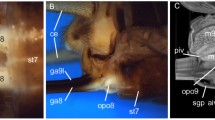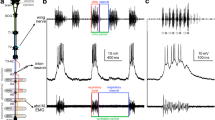Summary
-
1.
Bilateral pairs of heart accessory neurons (HA cells) have been identified on the ventral surface of the fifth and sixth segmental ganglia ofHirudo medicinalis. These neurons are rhythmically active and fire in a metastable phase relation to the heartbeat central pattern generator and heart activity.
-
2.
The HA neurons project into the contralateral roots of their own ganglion and innervate the contralateral heart. The HA neurons of the fifth ganglion (HA (5) cells) send axons into the contralateral anterior connectives and branch in several more anterior ganglia to form axons that project into the contralateral roots. The HA(6) neurons are similar but their intersegmental projection is directed posteriorly.
-
3.
The HA neurons receive rhythmic inhibitory synaptic input directly from the neurons of the heartbeat central pattern generator (HN interneurons). The HA cells also receive excitatory synaptic input, which can be spontaneous or driven by discharge in N mechanosensory cells.
-
4.
The HA neurons can induce myogenic activity in quiescent hearts and accelerate the rhythm of hearts that are already myogenic. The HA neurons can also increase the beat tension in hearts that are entrained by phasic excitatory drive from heart motor neurons (i.e. the activity of the heartbeat central pattern generator). These influences, are mediated by tonic activity in the HA neurons.
-
5.
The HA neurons appear to modulate the myogenic properties and contractile strength of the hearts.
Similar content being viewed by others
References
Adams ME, O'Shea M (1983) Peptide co-transmitter at a neuromuscular junction. Science 221:286–289
Bate M, Goodman CS, Spitzer NC (1981) Embryonic development of identified neurons: segment-specific differences in the H cell homologues. J Neurosci 1:103–106
Benson JA, Sullivan RE, Watson WH III, Augustine GJ Jr (1981) The neuropeptide proctolin acts directly onLimulus cardiac muscle to increase the amplitude of contraction. Brain Res 213:449–454
Blackshaw SE (1981) Sensory cells and motor neurons. In: Muller KJ, Nicholls JG, Stent GS (eds) Neurobiology of the leech. Cold Spring Harbor Laboratory, New York, pp 51–78
Calabrese RL (1977) The neural control of alternate heartbeat coordination states in the leech,Hirudo medicinalis. J Comp Physiol 122:111–143
Calabrese RL (1979) Neural generation of the peristaltic and nonperistaltic heartbeat coordination modes of the leech,Hirudo medicinalis. Am Zool 19:87–102
Calabrese RL, Peterson E (1983) Neural control of heartbeat in the leech,Hirudo medicinalis. Symp Soc Exp Biol 37:195–221
Cottrell GA, Schot LPC, Dockray GJ (1983) Identification and probable role of a single neurone containing the neuropeptideHelix FMRFamide. Nature 304:638–640
Evans PD, O'Shea M (1978) The identification of an octopaminergic neurone and the modulation of a myogenic rhythm in the locust. J Exp Biol 73:235–260
Goodman CS, Bate M, Spitzer NC (1981) Embryonic development of identified neurons: origin and transformation of the H cell. J Neurosci 1:94–102
Hauswirth DA, Noble D, Tsien RW (1968) Adrenaline: mechanism of action on the pacemaker potential in cardiac Purkinje fibers. Science 162:916–917
Krahl B, Zerbst-Boroffka I (1983) Blood pressure in the leech. J Exp Biol 107:163–168
Macagno ER (1980) The number and distribution of neurons in leech segmental ganglia. J Comp Neurol 190:283–302
Mann H (1962) Leeches (Hirudinea). Their structure, physiology, ecology and embryology. Pergamon Press, New York
Maranto AR, Calabrese RL (1984a) Neural control of the hearts in the leech,Hirudo medicinalis. I. Anatomy, electrical coupling, and innervation of the hearts. J Comp Physiol A 154:367–380
Maranto AR, Calabrese RL (1984b) Neural control of the hearts in the leech,Hirudo medicinalis. II. Myogenic activity and its control by heart motor neurons. J Comp Physiol A 154:381–391
May TE, Brown BE, Clements AN (1979) Experimental studies upon a bundle of tonic fibers in the locust extensor tibialis muscle. J Insect Physiol 25:169–181
Muller KJ, Nicholls JG, Stent GS (1981) An atlas of neurons in the leech,Hirudo medicinalis. In: Muller KJ, Nicholls JG, Stent GS (eds) Neurobiology of the leech. Cold Spring Harbor Laboratory, New York, pp 277–285
Nagy F, Dickinson PS (1983) Control of a central pattern generator by an identified modulatory interneurone in Crustacea I. Modulation of pyloric motor output. J Exp Biol 105:33–58
Painter SD, Greenberg MJ (1982) A survey of the responses of bivalve hearts to the molluscan neuropeptide FMRF amide and 5-hydroxytryptamine. Biol Bull 162:311–332
Payton B (1981) Structure of the leech nervous system. In: Muller KJ, Nicholls JG, Stent GS (eds) Neurobiology of the leech. Cold Spring Harbor Laboratory, New York, pp 27–34
Peterson EL, Calabrese RL (1982) Dynamic analysis of a rhythmic neural circuit in the leech,Hirudo medicinalis. J Neurophysiol 47:256–271
Piek T, Mantel P (1977) Myogenic contractions in locust muscle induced by proctolin and by wasp,Philanthus triangulum, venom. J Insect Physiol 23:321–325
Schwarz TL, Harris-Warrick RM, Glusman S, Kravitz EA (1980) A peptide action in a lobster neuromuscular preparation. J Neurobiol 11:623–628
Shafer MR, Calabrese RL (1981) Similarities and differences in the structure of segmentally homologous neurons that control the hearts in the leech,Hirudo medicinalis. Cell Tissue Res 214:137–153
Thompson WJ, Stent GS (1976a) Neuronal control of the heartbeat in the medicinal leech. I. Generation of the vascular constriction rhythm by heart motor neurons. J Comp Physiol 111:261–279
Thompson WJ, Stent GS (1976b) Neuronal control of the heartbeat in the medicinal leech. II. Intersegmental coordination of heart motor neuron activity by heart interneurons. J Comp Physiol 111:281–307
Thompson WJ, Stent GS (1976c) Neuronal control of the heartbeat in the medicinal leech. III. Synaptic relations of heart interneurons. J Comp Physiol 111:309–333
Weisblat DA (1981) Development of the nervous system. In: Muller KJ, Nicholls JG, Stent GS (eds) Neurobiology of the leech. Cold Spring Harbor Laboratory, New York, pp 173–195
Author information
Authors and Affiliations
Rights and permissions
About this article
Cite this article
Calabrese, R.L., Maranto, A.R. Neural control of the hearts in the leech,Hirudo medicinalis . J. Comp. Physiol. 154, 393–406 (1984). https://doi.org/10.1007/BF00605238
Accepted:
Issue Date:
DOI: https://doi.org/10.1007/BF00605238




